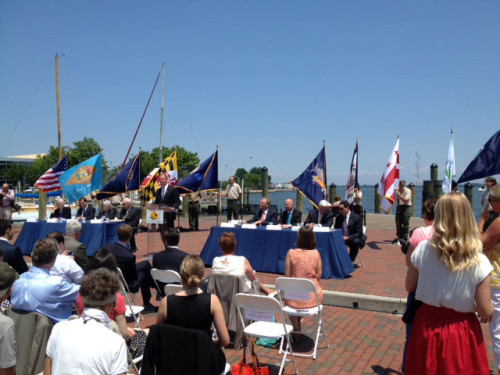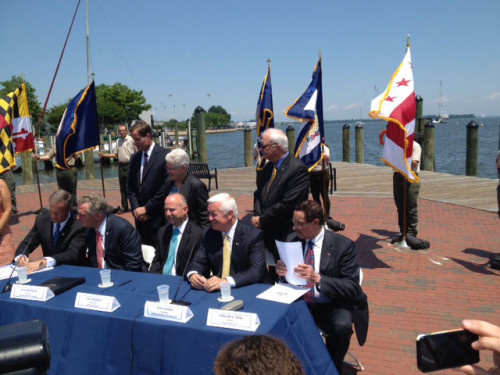2014 Chesapeake Bay Watershed Agreement
Bill Dennison ·I attended the Chesapeake Bay Executive Council meeting at the Maryland State House on 16 June 2014, followed by the press conference event for the signing of the new Chesapeake Bay Watershed Agreement on City Dock, Annapolis.


Governor Martin O'Malley is the current chair of the Chesapeake Bay Executive Council and served as the master of ceremonies of both events. The Governor spoke about the difference between dreams and goals was having measurable milestones with specific deadlines. He also talked about performance metrics tracked in a transparent way using websites like BayStat and ChesapeakeStat.

Joe Gill, Maryland Secretary of Natural Resources, introduced four high school students from Maryland, Virginia, Pennsylvania and Washington D.C. who have demonstrated leadership and made eloquent statements. The Maryland student thanked Governor O'Malley for his leadership in requiring an environmental literacy to their education. The Pennsylvania student from Lancaster spoke about the resilience of the Bay. The Washington D.C. student talked about how the Anacostia River restoration was important to the urban community. The Virginia student talked about the importance of cooperation and told us about his recent kayaking with dolphins. One of the themes with these students was the Chesapeake Bay Foundation support of educational programs.

Nick DiPasquale, Director of the Chesapeake Bay Program, talked about the sense of priority afforded the Chesapeake Bay Program, manifested as recent budget increases ($54 M up to $72 M per year). Nick also noted that this was the first agreement in which the 'headwater states' were included (West Virginia, New York and Delaware) in addition to the three states (Maryland, Virginia and Pennsylvania) and District of Columbia. He highlighted the features of the new Chesapeake Bay Watershed Agreement, including clarity, flexibility and transparency/accountability. The new agreement has ten goals and 30 outcomes which are achievable and measurable. Nick also highlighted climate change and toxics as new components not included in previous agreements. I appreciated that Nick specifically featured the New Insights report that we produced earlier this year.
John Dawes, Chair of the Citizens Advisory Committee, talked about how citizens could aid the strategies, resources and accountability of Chesapeake restoration. He noted the 2400 comments received during the public comment period, indicative of the high interest level. Sheila Noll, chair of the Local Government Advisory Committee, talked about important legislative initiatives in Maryland (upholding stormwater fees), Virginia (stormwater funding) and Pennsylvania (creation of stormwater authorities), and the need for training. Lisa Wainger, Vice-Chair of the Science and Technical Advisory Committee (STAC), talked about how the 38 independent scientists comprising STAC are interested in being partners in the restoration effort.
Virginia Governor Terry McAuliffe talked about his commitment to Chesapeake Bay and promised to reconvene the Virginia Climate Commission which has been dormant for the past four years. Environmental Protection Agency (EPA) Administrator Gina McCarthy talked about this being her first Executive Council meeting and pledged her support across the EPA for Chesapeake restoration. Governors Jack Markell (Delaware) and Tom Corbett (Pennsylvania) and Mayor Vincent Gray (Washington D.C.) all spoke about the initiatives in each of their jurisdictions.
The big question is "Will this new agreement make a difference?", which considering the multiple previous Chesapeake Bay agreements (1983, 1987, 2000), is a valid question. There are a few features about this 2014 agreement that bode well, including the incorporation of climate change, the two year milestones, and the broader engagement across the entire watershed. On the other hand, there are many who feel that this agreement is not particularly bold and falls short of achieving the changes necessary to achieve meaningful restoration. In addition, most of the agreement focuses on the various voluntary activities that can take place, when the regulatory initiative (Total Maximum Daily Load) is a major driver for water quality improvements. I think that it is important that thirty one years since the original agreement was signed, the political leadership around Chesapeake Bay is still working to accelerate restoration activities and come together to pledge their commitment to Chesapeake restoration.

About the author
Bill Dennison

Dr. Bill Dennison is a Professor of Marine Science and Vice President for Science Application at the University of Maryland Center for Environmental Science.

